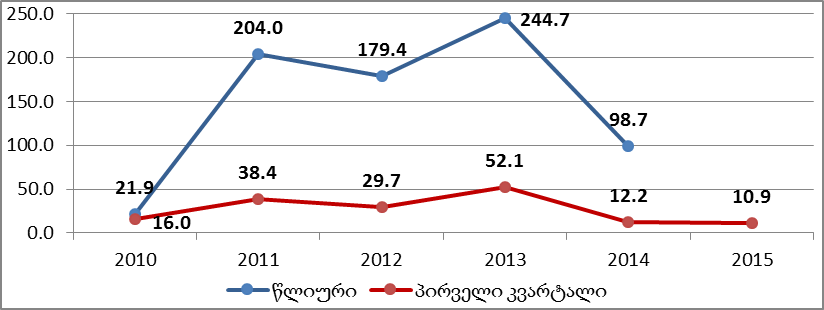On 28 July 2015, one of the leaders of the United National Movement, Zurab Tchiaberashvili, gave some information about the decrease in the number of socially vulnerable people. Mr Tchiaberashvili stated: "Since January 2013 up until the present day, the number of people who receive a subsistence allowance has decreased by 128,000 persons from 506,245 to 377,971. Meanwhile, the Ministry of Labour, Health and Social Affairs has cancelled the subsistence allowance for 30,000 pensioners, half of whom are single."
FactCheck verified the facts in Zurab Tchiaberashvili’s statement and tried to obtain information to explain the cut in subsistence allowances for a large portion of the socially vulnerable population.
A targeted social assistance governmental programme was launched in 2006. In 2010, the Government of Georgia approved a new methodology to assess the social and economic conditions of socially vulnerable families. The methodology’s formula includes three basic elements: family income, family property and family needs.
The first member of a family receiving social assistance (subsistence allowance) is supposed to receive GEL 30 whilst every other family member is entitled to receive GEL 24 upon a monthly basis. Since 1 July 2013, social assistance was doubled and the first member of the family receives GEL 60 whilst the others receive GEL 48.
Last year, the Ministry of Labour, Health and Social Affairs of Georgia with the support of UNICEF elaborated a new methodology to assess the social and economic conditions of socially vulnerable families. The new methodology envisages the introduction of a gradation of ranking points for socially vulnerable families. Each member of the family whose ranking points does not exceed 30,000 is entitled to receive GEL 30. Those with ranking points from 30,000 to 57,000 will receive GEL 50. The ranking points’ range from 57,000 to 60,000 entitles family members to receive GEL 40 in allowance whilst those with ranking points from 60,000 to 65,000 will receive GEL 30. Additionally, each socially vulnerable family whose ranking points do not exceed 100,000 is entitled to receive an extra GEL 10 per each child. The previous methodology of targeted social assistance did not envisage the extra assistance for children. Further additionally, those families whose ranking points exceeded 57,000 were not entitled to receive social assistance.
At the end of 2014, one of the leaders of the United National Movement, Zurab Tchiaberashvili, talked about the flaws in the new methodology to evaluate the households of socially vulnerable families (see FactCheck’s article).
Since 1 January 2015, the new methodology has been used to evaluate the social and economic conditions of socially vulnerable families in a test regime. The new methodology was supposed to come into force from the beginning of April of 2015. However, according to the decree of the Government of Georgia, issued on 31 March 2015, the new methodology entered into force from 1 May 2015 (see FactCheck’s article on this topic).
According to the statistical data of the Social Service Agency, in June 2015 as compared to May 2015, the number of families receiving a subsistence allowance dropped by 9,970 with the total number of assistance recipients having decreased by 26,648. As of the first six months of 2015, the number of families receiving social assistance was cut by 15,625 whilst the total number of assistance recipients was slashed by 43,416 individuals (see Graph 1).
Graph 1: Number of Families and Individuals Receiving Subsistence Allowance (December 2014 – June 2015)
 Zurab Tchiaberashvili compares the present day statistical data to the January 2013 statistical data in his statement. As compared to January 2013, the number of socially vulnerable families decreased by 38,210 and the total number of social assistance recipients decreased by 128,274 individuals in June 2015. It must be noted that according to the statistics of 2008-2015, the highest number of socially vulnerable individuals – 506,245 – was registered in January 2013. Therefore, the difference is also higher. If we compare the statistical data of June 2015 to that of October 2012, the number of subsistence allowance recipients is considerably lower (by 94,122 individuals and 27,239 families). However, in this case the difference is smaller as compared to 2013. Additionally, as illustrated by the statistics, the number of families and individuals who are entitled to receive social assistance constantly fluctuates. The dynamics of growth and decrease can be seen both under the previous and incumbent governments (see FactCheck’s article).
The number of recipients of social assistance decreased in every age category, including pensioners. The Minister of Labour, Health and Social Affairs, Davit Sergeenko, has commented upon this issue. The Minister stated: "I would not hesitate to say that it was a mistake. It was a mistake that single pensioners were put in a vulnerable group during these two months. Fortunately, we reacted in a timely manner and this mistake will be rectified and pensioners will get compensation for these months."
Single pensioners whose social assistance was stopped after the new methodology went into force will have their material assistance resumed after 20 August 2015. As stated by the Deputy Minister of Labour, Health and Social Affairs, Zaza Sopromadze, at a press conference on 5 August 2015, pensioners will also get reimbursements for the money which they were supposed to receive during this period.
The Ministry of Labour, Health and Social Affairs does not deny the fact that the number of socially vulnerable people did indeed decrease. According to the official explanation, the database of socially vulnerable people is constantly updated and the number of socially vulnerable individuals varies respectively. At the present moment, the new methodology is applied to evaluate the social and economic conditions of socially vulnerable families. It must be noted that some of them had their subsistence allowance cancelled whilst some of them had it temporarily stopped. If a socially vulnerable family retains its status after the completion of the evaluation, it will receive the reimbursement for that period when the subsistence allowance was stopped.
Conclusion
Statistical data illustrate that the number of families and individuals who receive social assistance is constantly altered. However, after the new methodology for the evaluation of the social and economic conditions of socially vulnerable families went into force, the number of socially vulnerable individuals dropped significantly. Additionally, the principal flaw comprised the cancellation of the subsistence allowance for single pensioners after they were evaluated using the new methodology. The Ministry of Labour, Health and Social Affairs intends to rectify the mistake by 20 August 2015.
In the first six months of 2015, the number of individuals receiving social assistance decreased by 43,416. In June 2015, as compared to May 2015, the number of individuals entitled to receive social assistance dropped by 26,648. However, Zurab Tchiaberashvili has compared those numbers to the highest indicator registered in 2008-2015 and, therefore, the difference was higher.
FactCheck concludes that Zurab Tchiaberashvili’s statement is MOSTLY TRUE.
Zurab Tchiaberashvili compares the present day statistical data to the January 2013 statistical data in his statement. As compared to January 2013, the number of socially vulnerable families decreased by 38,210 and the total number of social assistance recipients decreased by 128,274 individuals in June 2015. It must be noted that according to the statistics of 2008-2015, the highest number of socially vulnerable individuals – 506,245 – was registered in January 2013. Therefore, the difference is also higher. If we compare the statistical data of June 2015 to that of October 2012, the number of subsistence allowance recipients is considerably lower (by 94,122 individuals and 27,239 families). However, in this case the difference is smaller as compared to 2013. Additionally, as illustrated by the statistics, the number of families and individuals who are entitled to receive social assistance constantly fluctuates. The dynamics of growth and decrease can be seen both under the previous and incumbent governments (see FactCheck’s article).
The number of recipients of social assistance decreased in every age category, including pensioners. The Minister of Labour, Health and Social Affairs, Davit Sergeenko, has commented upon this issue. The Minister stated: "I would not hesitate to say that it was a mistake. It was a mistake that single pensioners were put in a vulnerable group during these two months. Fortunately, we reacted in a timely manner and this mistake will be rectified and pensioners will get compensation for these months."
Single pensioners whose social assistance was stopped after the new methodology went into force will have their material assistance resumed after 20 August 2015. As stated by the Deputy Minister of Labour, Health and Social Affairs, Zaza Sopromadze, at a press conference on 5 August 2015, pensioners will also get reimbursements for the money which they were supposed to receive during this period.
The Ministry of Labour, Health and Social Affairs does not deny the fact that the number of socially vulnerable people did indeed decrease. According to the official explanation, the database of socially vulnerable people is constantly updated and the number of socially vulnerable individuals varies respectively. At the present moment, the new methodology is applied to evaluate the social and economic conditions of socially vulnerable families. It must be noted that some of them had their subsistence allowance cancelled whilst some of them had it temporarily stopped. If a socially vulnerable family retains its status after the completion of the evaluation, it will receive the reimbursement for that period when the subsistence allowance was stopped.
Conclusion
Statistical data illustrate that the number of families and individuals who receive social assistance is constantly altered. However, after the new methodology for the evaluation of the social and economic conditions of socially vulnerable families went into force, the number of socially vulnerable individuals dropped significantly. Additionally, the principal flaw comprised the cancellation of the subsistence allowance for single pensioners after they were evaluated using the new methodology. The Ministry of Labour, Health and Social Affairs intends to rectify the mistake by 20 August 2015.
In the first six months of 2015, the number of individuals receiving social assistance decreased by 43,416. In June 2015, as compared to May 2015, the number of individuals entitled to receive social assistance dropped by 26,648. However, Zurab Tchiaberashvili has compared those numbers to the highest indicator registered in 2008-2015 and, therefore, the difference was higher.
FactCheck concludes that Zurab Tchiaberashvili’s statement is MOSTLY TRUE.
 Zurab Tchiaberashvili compares the present day statistical data to the January 2013 statistical data in his statement. As compared to January 2013, the number of socially vulnerable families decreased by 38,210 and the total number of social assistance recipients decreased by 128,274 individuals in June 2015. It must be noted that according to the statistics of 2008-2015, the highest number of socially vulnerable individuals – 506,245 – was registered in January 2013. Therefore, the difference is also higher. If we compare the statistical data of June 2015 to that of October 2012, the number of subsistence allowance recipients is considerably lower (by 94,122 individuals and 27,239 families). However, in this case the difference is smaller as compared to 2013. Additionally, as illustrated by the statistics, the number of families and individuals who are entitled to receive social assistance constantly fluctuates. The dynamics of growth and decrease can be seen both under the previous and incumbent governments (see FactCheck’s article).
The number of recipients of social assistance decreased in every age category, including pensioners. The Minister of Labour, Health and Social Affairs, Davit Sergeenko, has commented upon this issue. The Minister stated: "I would not hesitate to say that it was a mistake. It was a mistake that single pensioners were put in a vulnerable group during these two months. Fortunately, we reacted in a timely manner and this mistake will be rectified and pensioners will get compensation for these months."
Single pensioners whose social assistance was stopped after the new methodology went into force will have their material assistance resumed after 20 August 2015. As stated by the Deputy Minister of Labour, Health and Social Affairs, Zaza Sopromadze, at a press conference on 5 August 2015, pensioners will also get reimbursements for the money which they were supposed to receive during this period.
The Ministry of Labour, Health and Social Affairs does not deny the fact that the number of socially vulnerable people did indeed decrease. According to the official explanation, the database of socially vulnerable people is constantly updated and the number of socially vulnerable individuals varies respectively. At the present moment, the new methodology is applied to evaluate the social and economic conditions of socially vulnerable families. It must be noted that some of them had their subsistence allowance cancelled whilst some of them had it temporarily stopped. If a socially vulnerable family retains its status after the completion of the evaluation, it will receive the reimbursement for that period when the subsistence allowance was stopped.
Conclusion
Statistical data illustrate that the number of families and individuals who receive social assistance is constantly altered. However, after the new methodology for the evaluation of the social and economic conditions of socially vulnerable families went into force, the number of socially vulnerable individuals dropped significantly. Additionally, the principal flaw comprised the cancellation of the subsistence allowance for single pensioners after they were evaluated using the new methodology. The Ministry of Labour, Health and Social Affairs intends to rectify the mistake by 20 August 2015.
In the first six months of 2015, the number of individuals receiving social assistance decreased by 43,416. In June 2015, as compared to May 2015, the number of individuals entitled to receive social assistance dropped by 26,648. However, Zurab Tchiaberashvili has compared those numbers to the highest indicator registered in 2008-2015 and, therefore, the difference was higher.
FactCheck concludes that Zurab Tchiaberashvili’s statement is MOSTLY TRUE.
Zurab Tchiaberashvili compares the present day statistical data to the January 2013 statistical data in his statement. As compared to January 2013, the number of socially vulnerable families decreased by 38,210 and the total number of social assistance recipients decreased by 128,274 individuals in June 2015. It must be noted that according to the statistics of 2008-2015, the highest number of socially vulnerable individuals – 506,245 – was registered in January 2013. Therefore, the difference is also higher. If we compare the statistical data of June 2015 to that of October 2012, the number of subsistence allowance recipients is considerably lower (by 94,122 individuals and 27,239 families). However, in this case the difference is smaller as compared to 2013. Additionally, as illustrated by the statistics, the number of families and individuals who are entitled to receive social assistance constantly fluctuates. The dynamics of growth and decrease can be seen both under the previous and incumbent governments (see FactCheck’s article).
The number of recipients of social assistance decreased in every age category, including pensioners. The Minister of Labour, Health and Social Affairs, Davit Sergeenko, has commented upon this issue. The Minister stated: "I would not hesitate to say that it was a mistake. It was a mistake that single pensioners were put in a vulnerable group during these two months. Fortunately, we reacted in a timely manner and this mistake will be rectified and pensioners will get compensation for these months."
Single pensioners whose social assistance was stopped after the new methodology went into force will have their material assistance resumed after 20 August 2015. As stated by the Deputy Minister of Labour, Health and Social Affairs, Zaza Sopromadze, at a press conference on 5 August 2015, pensioners will also get reimbursements for the money which they were supposed to receive during this period.
The Ministry of Labour, Health and Social Affairs does not deny the fact that the number of socially vulnerable people did indeed decrease. According to the official explanation, the database of socially vulnerable people is constantly updated and the number of socially vulnerable individuals varies respectively. At the present moment, the new methodology is applied to evaluate the social and economic conditions of socially vulnerable families. It must be noted that some of them had their subsistence allowance cancelled whilst some of them had it temporarily stopped. If a socially vulnerable family retains its status after the completion of the evaluation, it will receive the reimbursement for that period when the subsistence allowance was stopped.
Conclusion
Statistical data illustrate that the number of families and individuals who receive social assistance is constantly altered. However, after the new methodology for the evaluation of the social and economic conditions of socially vulnerable families went into force, the number of socially vulnerable individuals dropped significantly. Additionally, the principal flaw comprised the cancellation of the subsistence allowance for single pensioners after they were evaluated using the new methodology. The Ministry of Labour, Health and Social Affairs intends to rectify the mistake by 20 August 2015.
In the first six months of 2015, the number of individuals receiving social assistance decreased by 43,416. In June 2015, as compared to May 2015, the number of individuals entitled to receive social assistance dropped by 26,648. However, Zurab Tchiaberashvili has compared those numbers to the highest indicator registered in 2008-2015 and, therefore, the difference was higher.
FactCheck concludes that Zurab Tchiaberashvili’s statement is MOSTLY TRUE.








